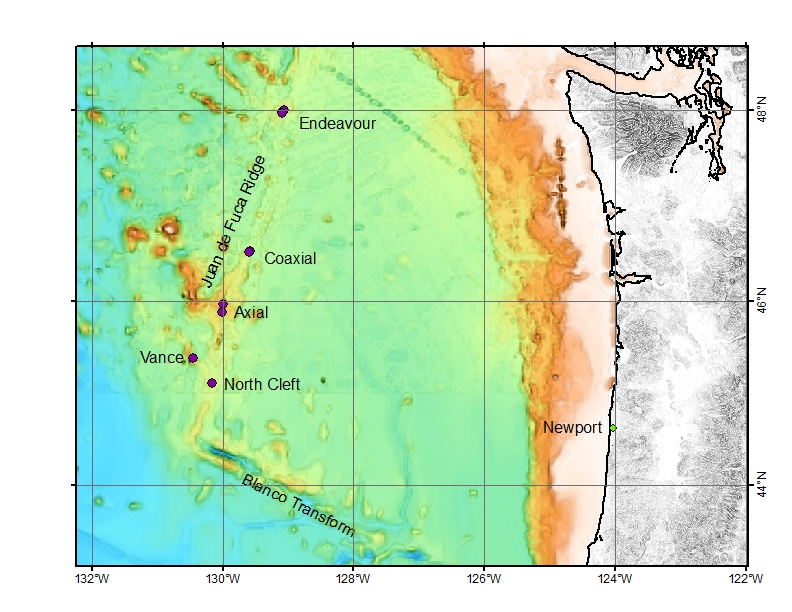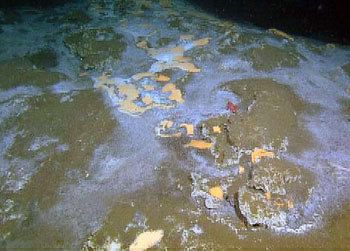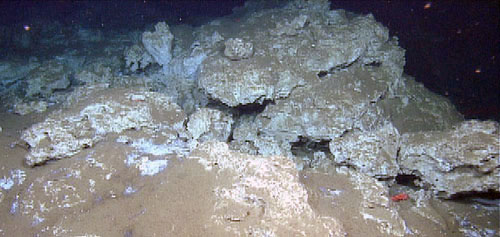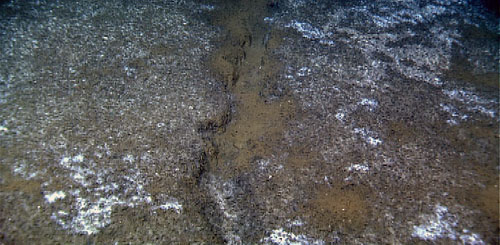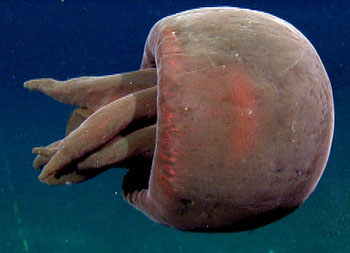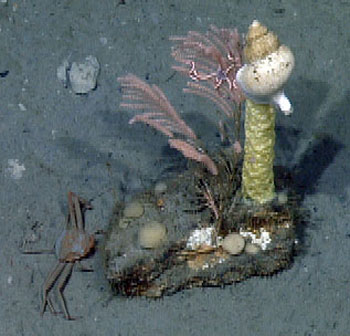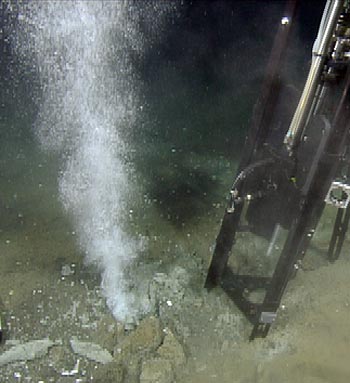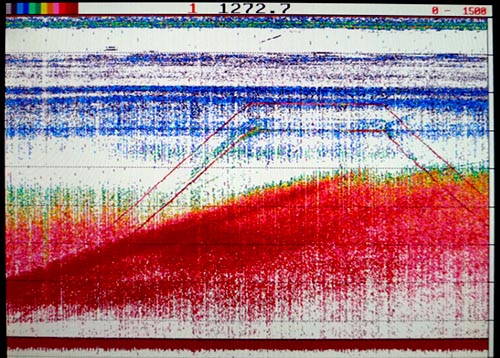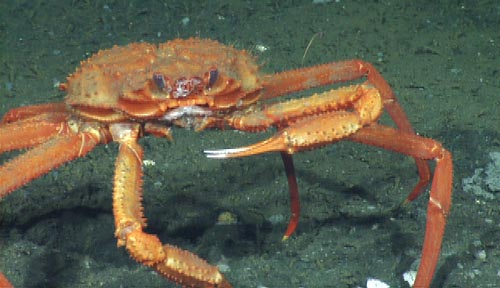 | Tully Gas Vent Field and north part of the ocean |
|
Plumes of bubbles emanating from the seafloor drew researchers to explore this new site |
White, yellow, and orange mats of different types of bacteria covered sections of the newly discovered area. The bacteria thrive on methane as their energy source. |
Large slabs of carbonate rocks with big cavities and pits found in parts of the site indicate gas has been actively venting there for a very long time, probably many thousands of years |
Vancouver. This large field of bacterial mat, about 250 meters long and five-to-ten meters wide, closely followed a crack in the seafloor - http://www.mbari.org/expeditions/Northern11/L3/logbook/day5.htm |
Tiburonia granrojo, a jelly that can grow to as much as three meters across, was spotted on todayÆs dive, so we followed it briefly to get some good video footage. The animal was first described by MBARI scientist George Matsumoto |
Vancouver. A parting shot for the day, just before bringing the ROV up to the surface, we encountered this seafloor still life. Well, probably not so still, since these animals are alive. The sea life in this picture includes a juvenile tanner crab (Chionoecetes), corals (sea fans) in the family Primnoidae, a brittle star perched on one of the sea fans, and a Neptunea snail sitting on an egg mass |
Spinnaker Gas Vent -A chandelier on the seafloor? Actually itÆs a conglomeration of tanner crabs, tubeworms, and Neptunea snails sitting on their egg towers that look like corn cobs - http://www.mbari.org/expeditions/Northern11/L3/logbook/day6.htm |
Spinnaker Gas Vent-Benthoctopus and Neptunea snails on the seafloor - - http://www.mbari.org/expeditions/Northern11/L3/logbook/day6.htm |
Spinnaker Gas Vent-This forceful gusher of gas bubbles flowed for at least a couple of hours after we poked around in the seafloor where a strong methane signal had been detected. The gas was trapped at shallow depth below the seafloor-http://www.mbari.org/expeditions/Northern11/L3/logbook/day7.htm |
The bubble stream was so forceful it showed up clearly on the shipÆs sonar. The red section rising up from the bottom of the image (representing the seafloor at a depth of 1,272 meters) is the acoustic signal bouncing off the methane gusher. Notice the thin red lines going up, across, and back down; these represent the remotely operated vehicle on its brief journey to 400 meters to clear the laser probe of hydrate. The gas plume dissolves well before reaching the surface |
This crab dipped its claws into the bottom of the gusher to get a snack and put something in its mouth. Soon we saw hydrate forming on its face and in its mouth. Apparently the crab realized this was not a good place for healthy food and started picking at its mouth to pull out the ice-like hydrate that had gotten stuck there |
This crab dipped its claws into the bottom of the gusher to get a snack and put something in its mouth. Soon we saw hydrate forming on its face and in its mouth. Apparently the crab realized this was not a good place for healthy food and started picking at its mouth to pull out the ice-like hydrate that had gotten stuck there |
from MBARI -http://www.mbari.org/expeditions/Northern11/L3/logbook/day2.htm
Location: Tully Gas Vent Field
Latitude: 45░ 55.3947 N
Longitude: 129░ 58.9764 W
Axial sea mounth
Location: Off the coast of Vancouver
Latitude: 48║ 40.13 N
Longitude: 126║ 50.85 W
Location: Spinnaker Gas Vent site
Latitude: 48º 42.86 N
Longitude: 126º 54.1463 W
Location: Spinnaker Gas Vent site
Latitude: 48º 40.47 N
Longitude: 126º 50.46 W
Large pockets of methane gas in the seafloor can change the shape of the terrain. So when an otherwise flat expanse of seafloor is punctuated by many small mounds, like blisters on an overworked hand, thereÆs a good chance that they were created by the growing methane pressure from below. Careful surveys of two such mounds today helped to verify that theory.
The new tripod first used a few days ago to improve the use of the laser Raman probe was sent back to the seafloor. With the new handle that pilot Randy Prickett built onboard and the lessons learned from the first deployment, the tripod became an excellent tool for conducting surveys. This new contraption made it easy to conduct perfect, clean, controlled insertion of the probe into the seafloor, even if the mud was difficult to penetrate
